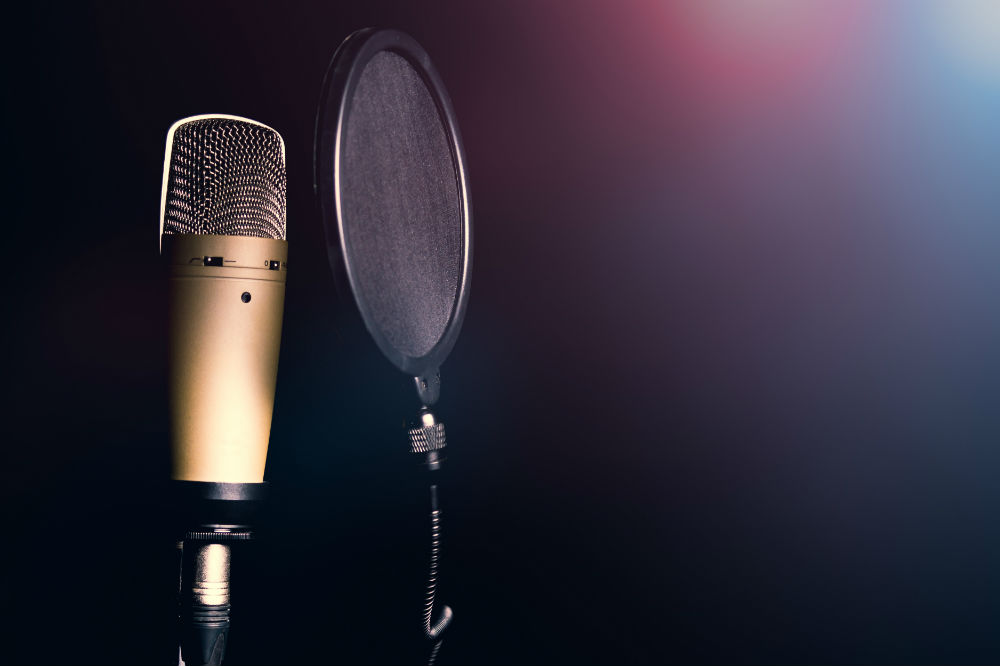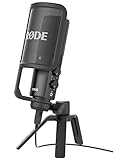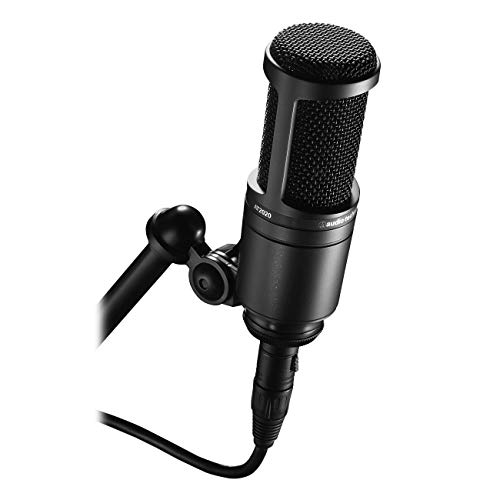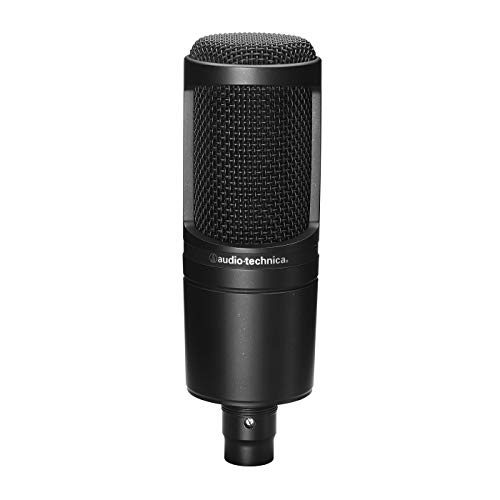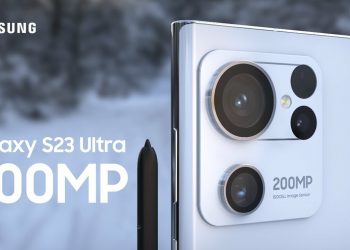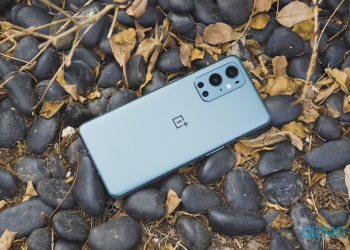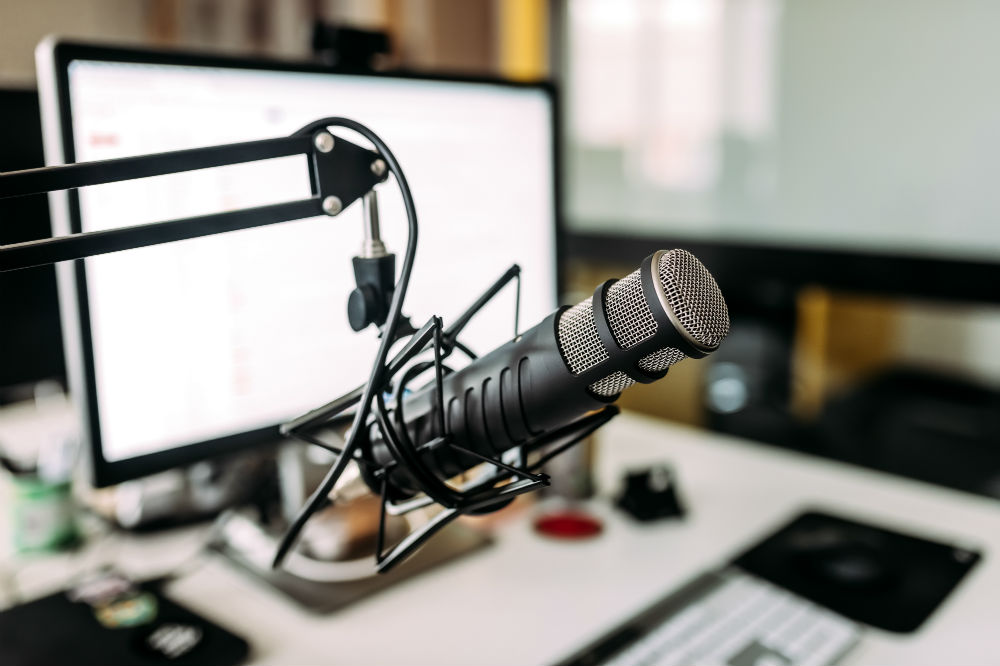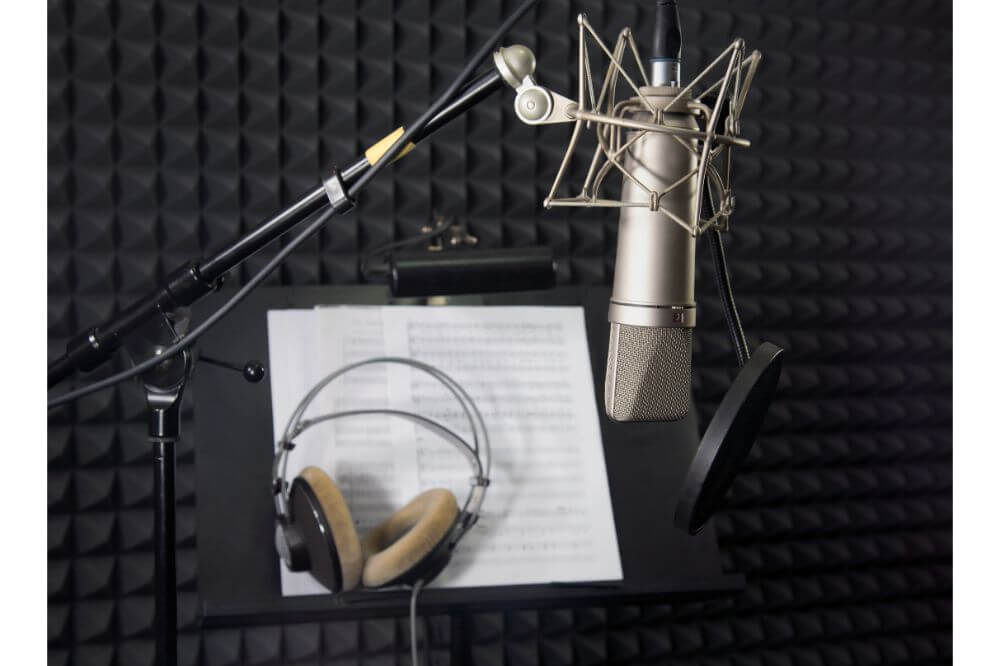Updated on April 2nd, 2022
Condenser mics are widely praised for their ability to record a variety of instruments. Compared to other mic types, condenser microphones follow sound waves of any frequency much more accurately. They are very sensitive to sound, which makes them incredible recording tools.
Choosing the perfect music equipment for your studio is never easy, and you’d probably just end up going for the most expensive option. With condenser mics, however, the competition is quite packed at the top. Here’s a list of five excellent mics to help you pick the best condenser mic for your needs.
Best Condenser Mic Comparison Chart
Best Condenser Mic Reviews
Blue Snowball iCE
This cool USB mic is more than it seems at first glance. Easily compatible with most PCs, you can rest assured that it will work on your computer. The Snowball iCE from Blue is an orb-shaped condenser mic that comes with a tripod stand.
Product Highlights
The Blue Snowball iCE is available in black and white, and it is shaped rather weirdly for a condenser microphone. Its orb-like shape makes it look more like a camera, while the fact that it comes with a tripod it can be screwed on doesn’t make it look like a professional recording mic right off the bat.
However, an experienced sound engineer or musician who knows what they’re doing can make it work for a variety of projects. Make no mistake, the Snowball iCE is capable of creating a detailed, crisp, and focused audio. Its cardioid polar pattern works great for YouTubers, especially given the fact that a cardioid-pattern mic won’t pick up as much of your keyboard sounds and the mouse like a mic with an omnidirectional pattern would.
Its parent company clearly wanted to make a simple condenser mic that would work on any platform. From Windows 7, 8, and 10 to Mac OS, as long as your computer has 64MB of RAM and a USB 1.1/2.0 slot, this little microphone will work.
The Good
What’s interesting about this particular microphone is that it’s very basic. You can literally just plug it into your laptop and proceed to record. That’s it! Most other condenser mics require a particular setup or at least an XLR slot on your sound card. Although you probably do use a sound card, being able to record on the go can be a very useful thing, and this mic is quite sensitive to sound and distortion, which is a great thing. Oh, and it’s also rather cheap.
The Bad
The Blue Snowball iCE’s tripod is simply too short. Seeing as how one of the main goals of this mic is to allow you solid recording options in inconvenient spaces, this can turn out a problem. The sample rate of 44.1kHz/16-bit might not be in the range of mics with 24-bit signal, but the Snowball’s sample rate is more than good for recording YouTube narrations. Plus, its 24-bit peers tend to be twice as expensive, so it’s a nice budget-friendly option for YouTubers and vloggers who don’t need high-end audio equipment.
Pros
- Very budget-friendly
- Only needs a USB connection
- Sensitive to sound and distortion
- Perfect for YouTube and recordings
- Detailed, crisp, and focused audio performance
Cons
- Tripod too short
- Making it work with some DAWs may require some expertise
CHECK LATEST PRICE ON AMAZON.COM
Audio-Technica AT2020
A very versatile medium-diaphragm condenser mic, the AT2020 from Audio-Technica is perfect for an acoustic setting with its warm sound and minimal harshness. The microphone comes with a pouch and a stand.
Product Highlights
The AT2020 is a cardioid condenser mic, which means that it only picks up sounds from the direction it is pointed at. It bears the looks of a large diaphragm condenser mic, but its 16mm back-electret capsule indicates that the AT2020 is a medium diaphragm mic.
Audio-Technica’s AT2020 boasts a full, warm sound, without harshness, meaning that it is most suitable for acoustic music. Owing to its flat response, it works perfectly with both female and male vocals. The AT2020 has a max SPL rating of 144db and a dynamic range of 124db which helps the model tackle most sources rather easily.
This medium diaphragm condenser microphone comes with a built-in USB output and headphone jack, a pivoting stand, and a small storage pouch. While this one may not be the best condenser mic in the world, it is certainly very versatile.
The Good
The AT2020 is definitely in the best condenser mic category when it comes to entry-level mics. It is both affordable, as well as more than capable of providing decent sound quality. Its versatility is one of its main strong points. This medium diaphragm condenser mic has quite a wide range of applications, from voice work and vocals to acoustic instruments of various kinds. Its design (sturdy wire mesh cover and solid metal construction) is excellent and its price-to-quality ratio is excellent.
The Bad
Self-noise is the main downside of this product. Although not brilliant, AT2020’s noise figure stands at the high side of average, which is perfectly satisfactory for some, but might not be good enough for seasoned experts. Another big downside here is that it doesn’t come with a shock mount, but this was obviously done in order to keep the price low.
Pros
- Great entry-level mic
- Very affordable
- Extremely versatile when it comes to acoustic music
- Excellent design and build
Cons
- Self-noise level might be too high for seasoned experts
- No shock mount
CHECK LATEST PRICE ON AMAZON.COM
Rode NT-USB
A great mic with crystal-clear audio, the Rode NT-USB is excellently suited for recoding vlogs and podcasts, but it truly shines in the music recording environment. Despite its quality, the Rode NT-USB doesn’t require an expensive setup.
Product Highlights
These days, as a professional singer or YouTuber, you have to deliver excellent audio. This means that investing in a fantastic mic that is capable of delivering fantastically clear audio pretty much goes without saying. This is exactly where the Rode NT-USB shines. Not only does this unit from Rode deliver professionally clear sound, but it is also quite the looker.
The Rode NT-USB is primarily intended for vocal singing, instrumentals, and voiceover. This means that the sound it produces is top-notch. On sung vocals and spoken voice, the Rode NT-USB delivers a perfect amount of low-end warmth, without sacrificing top-end clarity. Tonal anomalies are almost nonexistent.
This condenser mic is marketed as the closest you can get to impeccable sound quality without a mind-bogglingly expensive studio setup. Sure, the price is somewhat steeper than that of its competitors. But the performance makes it a strong contender for the best condenser mic in its class.
The Good
The quality of the recordings is exceptionally good. To an untrained ear, this condenser microphone can easily make it seem as though the recording was done in a professional studio. This is very important because most people will not notice the difference, meaning that you should really consider whether investing in an expensive studio setup is worth it. Its built-in headphone amp is both loud and clear and there is little to no self-noise.
The Bad
First and foremost, this is one of the most expensive condenser microphones in its category. This can prove a turn-off for anybody who’s looking to do some basic YouTubing, as there are many similar mics out there that offer more than decent sound quality for much less money. Additionally, the Rode NT-USB only has one pickup pattern (cardioid), making it less suitable for interviews and group chats.
Pros
- Extremely good recording quality for vocals, voice-overs, and instrumentals
- Can serve as a replacement for a studio setup
- Encompasses the microphone, a preamp, and digital conversion
- Perfect for solo recording
Cons
- Somewhat expensive when compared to its peers
- Less suitable for interviews and group chats
CHECK LATEST PRICE ON AMAZON.COM
Fifine K669B
An extremely affordable podcast mic, the Fifine K669B may not be a perfect piece of gear, but the number of features you get for a price this low is more than enough. If you’re looking for a good beginner condenser mic, this is an excellent low-budget option.
Product Highlights
Primarily, this is a budget condenser mic. It works really well for voiceovers and live streams, and it is everything you need for a basic podcast. The mic is USB-powered, which makes it highly portable, and features a cardioid polar pattern for reducing static noise.
This also makes the Fifine K669B great for gamers, helping them isolate the sound properly and providing decent audio. It produces crisp, clear, and smooth sound and almost completely eliminates the static noise, making it an even better fit for gamers and streamers.
However, you can’t expect a feature-packed product in a box that costs this little. Still, the price tag is so low that you may even buy it, just for the sake of checking it out. On top of that, the Fifine K669B doesn’t require the 48v Phantom power supply, which is very convenient.
The Good
You’d be hard-pressed to find another condenser microphone on the market that’s this cheap. The K669B comes with a sturdy metal construction design and a solid, stable tripod. It also has an additional volume knob that allows for a clearer, louder output. The fact that it is USB-powered means that you won’t have to struggle with the 48v Phantom power supply. This may not seem important, but when you have a ton of cables running all around your room, avoiding cluttering it with even more is essential.
The Bad
Although it has a more than satisfying price-to-quality ratio, the Fifine K669B isn’t a professional recording tool. This is fine because it isn’t even trying to be, but it still might not be the right choice for professionals who would rather pay more for a feature-packed microphone. This condenser mic is clearly aimed at the less professional crowd who is looking to buy audio equipment on a budget.
Pros
- Very cheap
- Great build quality
- Solid sound for the money
- USB-powered
- Volume knob for clearer, louder audio
Cons
- Might not appeal to experts
- Can’t connect to phones and tablets
CHECK LATEST PRICE ON AMAZON.COM
Shure MV88
This condenser mic is a tiny, versatile beast. What GoPro is to the video world, the MV88 is to the audio world. There is no better way to make your iPhone recordings sound professional and perfect.
Product Highlights
The MV88 from Shure is incredibly tiny. It is commonly used for recording on iOS devices. Very convenient and simple to use, the aim of this mic is to make your Apple device footage sound just as good as it looks. It is much smaller than the width of the iPhone screen, which is approximately 2.7”. It also comes with a zip-up case and a short 3.5mm cable.
Most importantly, it is capable of providing an excellent mic signal, with crisp highs and rich lows. You can adjust its DSP or disable it completely, which is an excellent feature, what with all the debate about whether or not a condenser mic should feature DSP.
The idea behind the Shure MV88 is to create the best condenser mic for the iPhone and iPad. This is a great idea, as Apple devices tend to have amazing cameras with a 1080p 4K option. If you’re unhappy with the sound quality your iPhone/iPad recordings, this mic might be a good choice.
The Good
The MV88 complements your phone well and doesn’t obstruct you from using your iPhone or iPad completely normally. The device’s app, the ShurePlus Motiv App, brings a ton of settings to the table, such as stereo width, as well as switching to mono modes. This device is truly fantastic for creating quality content while you’re outside. People watching the videos you record with the Shure MV88 won’t believe that you didn’t use an expensive camera.
The Bad
The price might be too steep for some consumers. Even though most Apple gear is on the higher end of the price spectrum, Shure didn’t have to slap this price tag on a device so small. Another thing with small devices is that they can easily get lost, and that’s quite a pricey piece of gear. Also, if you have a cover on your iPhone, you’ll probably have to take it off to use this one.
Pros
- Very small and convenient
- Delivers excellent audio
- Crisp highs and rich lows.
- Excellently designed app
- Very versatile
Cons
- Expensive
- Doesn’t work well with iPhone covers
CHECK LATEST PRICE ON AMAZON.COM
Buyer’s Guide
With the number of products currently available on the market, knowing what you need and what to look for is very important. If you’re buying your first condenser mic and don’t know too much about them, you’ll want to read on. Keep in mind that you’re usually best off buying an affordable product first, rather than spending a ton on a beast of a microphone. This is important not only for your budget but also so that you can learn what to look for when you decide to upgrade.
First of all, you should pick the condenser microphone type that you need. Then you should look at its connectivity properties – there’s no use in buying a product that won’t fit with your current gear. Researching polar patterns will tell you how a particular microphone picks up sound. Finally, looking at its applications will tell you how well a particular model will work for your needs.
Types of Condenser Microphones
Essentially, there are two main types of condenser mics, small-diaphragm and large-diaphragm. Small-diaphragm microphones are best used for capturing natural and pure sound. They do not exaggerate the signal and are applicable to almost anything. Large-diaphragm condenser microphones, on the other hand, are used when you want your sound to be big and warm. They are typically used for vocals and some instruments because they accentuate the low frequencies.
Connectivity
Depending on your needs, you may want to choose your condenser mic based on connectivity. Some models require both an XLR input and a USB input or a 48v Phantom power supply, while others need only a USB connection. Of course, some microphones are made with phone and tablet connectivity in mind, like the ShureMV88.
Some people prefer simplicity and the ability to record solid sound quality on the go and will go for USB-only mics, while others who use pro equipment will get a condenser mic that requires multiple inputs. As a rule, the more demanding the connectivity is, the better the sound will be. Think carefully about connectivity when buying a microphone.
Frequency Response
The frequency response shows you the range of frequencies that your microphone will pick up. For instance, the best condenser mic for the bass drum would start at a low frequency of 30Hz, while the vocals will work best with a mic with the frequency response range of 80Hz-15kHz.
This is why professional studios tend to use multiple condenser mics even if they are of the same type.
Polar Patterns
The range of frequencies that a mic captures doesn’t tell the whole story, however. The term polar pattern is associated with how a microphone picks up the sound. That is to say how sensitive it is to sound waves coming from various directions. There are two different types of condenser microphones in terms of their polar patterns: omnidirectional and directional.
The difference is relatively simple to digest. An omnidirectional microphone picks up the sound from all directions equally, while a directional mic is designed so that it picks up the sound from a single direction. The former are used in moviemaking, interviews, and when trying to capture ambiance sounds, while the latter are used for professional music recording and in instances where you’d want to isolate all the noise coming from a variety of directions.
Microphone Applications
Large diaphragm condenser microphones are the best choice for vocal recording, as a great deal of attention is required to capture the nuances in the singer’s performance. On the other hand, small diaphragm microphones are used for capturing the cymbals on the drum kit, while the snare, bass, and toms are best left to dynamic cardioid microphones.
The acoustic guitar goes best with a cardioid condenser mic, although it needs to be well-placed and the movement of the performer limited. Electric guitar amps, on the other hand, tend to be loud, which means that a well-positioned hyper cardioid dynamic mic will work the best. However, a condenser mic set back at a distance can be used to capture multiple amps for a more natural feel.
Condenser Microphone FAQ
What is a condenser microphone?
A condenser microphone is a microphone type that boasts increased sensitivity to sounds. It is mostly used in the studio or home settings due to its ability to capture the tiniest nuances in vocal and instrumental performances. Some condenser mics also make for great live performance fits. There are two main types of a condenser mic, those with large diaphragm and small diaphragm.
What are the benefits of a condenser mic?
As a sensitive recording tool, a condenser mic delivers fantastic performance in professional and home recording studios. In comparison to dynamic microphones, condenser mics are capable of capturing a much better tonal picture with attention to details. They are used for recording vocals, guitars, drums, piano, electric bass, and the majority of other common and less common instruments.
How does a condenser microphone work?
The term ‘condenser’ means ‘capacitor,’ which is an electronic component storing the energy. As such, condenser microphones require a power supply from either a battery or an external source. Owing to this, the audio signal is stronger than what you would get with a dynamic mic. Because of their design and features, condenser mics are sensitive and very responsive and thus not suitable for high volumes.
The capacitor component has two plates with a certain voltage between them. One of these two plates is light and essentially acts as the diaphragm. The incoming sound waves strike the diaphragm plate and cause it to vibrate, which changes the distance between the plates and therefore changes the capacitance.
How to choose a microphone
Your choice of a microphone should be based solely on your needs as a content creator, musician, or recorder. All expensive condenser mics can be used for basic and advanced purposes, but most top-of-the-line models require additional equipment that costs even more money and takes up even more space.
If you want to be able to create content with good audio, your best bet would be either the mobile Shure MV88 or the Blue Snowball iCE. For advanced studio recording purposes, you might want to set aside a larger budget for obtaining solid studio equipment to go along with an advanced condenser microphone.
What’s the difference between condenser and dynamic mics?
Condenser mics are much more sensitive than dynamic mics, and are thus capable of picking up nuances and details in tonal properties of an instrument or vocals. However, they are not made for live performance purposes, as they do not work well in loud environments.
On the other hand, dynamic mics aren’t capable of capturing the tiniest of details when it comes to audio properties, but work much better than condenser mics in live performances like shows, gigs, and stage appearances.
Final Verdict
The Rode NT-USB is perhaps the best overall choice here. Although it comes at a steep price, the features that it offers and the general audio quality pretty much beat the competition. The crystal-clear sound it provides and its practicality when it comes to size and comfort make this condenser mic truly a brilliant choice for any purpose. It is small and practical enough for narrating video content in real-time, but it’s also a perfect fit for recording vocals and instruments.
On the other hand, the Fifine K669B is so affordable that you won’t make a mistake buying it even if you don’t exactly need a new condenser mic. This small, practical, plug-and-play USB microphone is an excellent starting point for beginners and a fantastic choice for those who are looking for an affordable solution for their audio recording. Plus, it works on pretty much every computer out there.
More to read:
Best Stand Mixers in the U.S. That Are Selling Like Hot Cakes 2021 Acekool Stand Mixer
We hope you love our reviews! For your information, we do earn money from commission in the link in the content! For more information click here!

